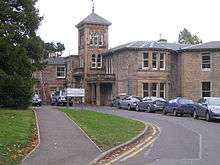Astley Ainslie Hospital
The Astley Ainslie Hospital is a Community Hospital in Edinburgh, Scotland. It is operated by NHS Lothian.[1] It is situated in the affluent Grange area of Edinburgh.
The hospital specialises in rehabilitative care for people who have suffered brain injuries, stroke, orthopaedic or cardiac conditions and respite care for elderly people.[2]
History
The Astley Ainslie Hospital opened in 1923. Mr David Ainslie, who died in 1900, left a sum of money for the purpose of building and endowing a hospital or institution for convalescents from the Royal Infirmary of Edinburgh. He wanted it to be called the Astley Ainslie Institution.[3] The landscaping of the grounds was executed by Roland Edgar Cooper, just prior to his becoming Head Curator of the Royal Botanic Gardens Edinburgh.[4]
When the hospital opened there were 14 beds for female convalescent patients. Over the years the hospital has expanded and now has beds for the rehabilitation and continuing care of older people. The wards and other buildings are named after famous doctors, nurses and administrators, or to commemorate people who have had a significant association with the hospital.

Many stones of ecclesiastical origin have been found in the grounds of the Astley Ainslie Hospital and in private gardens in the neighbourhood. A collection of these, some bearing initials and dates, was built into a specially constructed stone panel by Col. John Fraser, when Medical Superintendent, in the S boundary wall of his residence, South Bank. Also to be seen in the hospital grounds are a draw-well and a font or trough at the foot of the lawn of Morelands, a very old sunken well in what was the garden of Canaan Park, and just beyond the S boundary wall of South Bank, the remains of another old draw-well and those of an early building of some kind. To the W of the lean-to greenhouse in what was formerly the garden of Millbank villa, are, embedded in the ground, a row of four large cylindrical stones, bearing sculpted emblems of the Passion of Christ. Traditionally, these remains were believed to have been part of St Roque's Chapel, but modern opinion considers that they came from Trinity College Church. Another possibility is that they came from St Giles' .
Wards
The Astley Ainslie has 11 wards: Charles Bell 1, Charles Bell 2, East Pavilion A, East Pavilion B, Fraser, Mccallum, Mears, Miles, Millbank A, Millbank B and Sutherland ward.
Smart Centre
The hospital houses the Southeast Mobility and Rehabilitation Technology Centre, run by NHS Lothian, commonly known as the SMART Centre. In 2007 a new centre opened to house clinical, technical, office and storage facilities for a range of rehabilitation services.[5] The centre provides 4,000 m2 of space and cost £7.5 million to construct, incorporating a number of environmentally friendly features.[6]
It offers wheelchair fitting, prosthetic fitting and maintenance, a disabled living centre which helps people stay in their own home by providing stairlifts, bathroom and kitchen equipment and walking aids. It also offers driving assessments for disabled people who wish to start or restart driving after an illness or disability.
The Service is accessible by people within NHS Lothian, NHS Fife and NHS Borders.
It is proposed to demolish the hospital as part of the blueprint to stop bed blocking and revolutionise care in the community.[7]
References
- ↑ "Going to hospital: locations: Astley Ainslie Hospital". NHS Lothian. 5 June 2014. Retrieved 8 July 2014.
- ↑ "Your guide to the Astley Ainslie Hospital: Information for patients, relatives and carers" (PDF). NHS Lothian. March 2009. Retrieved 8 July 2014.
- ↑ History of Astley Ainslie Hospital - Lothian Health Services Archives
- ↑ http://stories.rbge.org.uk/archives/4224
- ↑ "About us". Southeast Mobility and Rehabilitation Technology Centre. Retrieved 8 July 2014.
- ↑ "Press releases: State-of-the-art SMART Centre to Celebrate Official Opening". NHS Lothian. 28 February 2007. Retrieved 13 August 2014.
- ↑ "Hospitals facing care village axe". Edinburgh News. 9 April 2014. Retrieved 27 December 2014.
Coordinates: 55°55′50″N 3°11′50″W / 55.93056°N 3.19722°W
